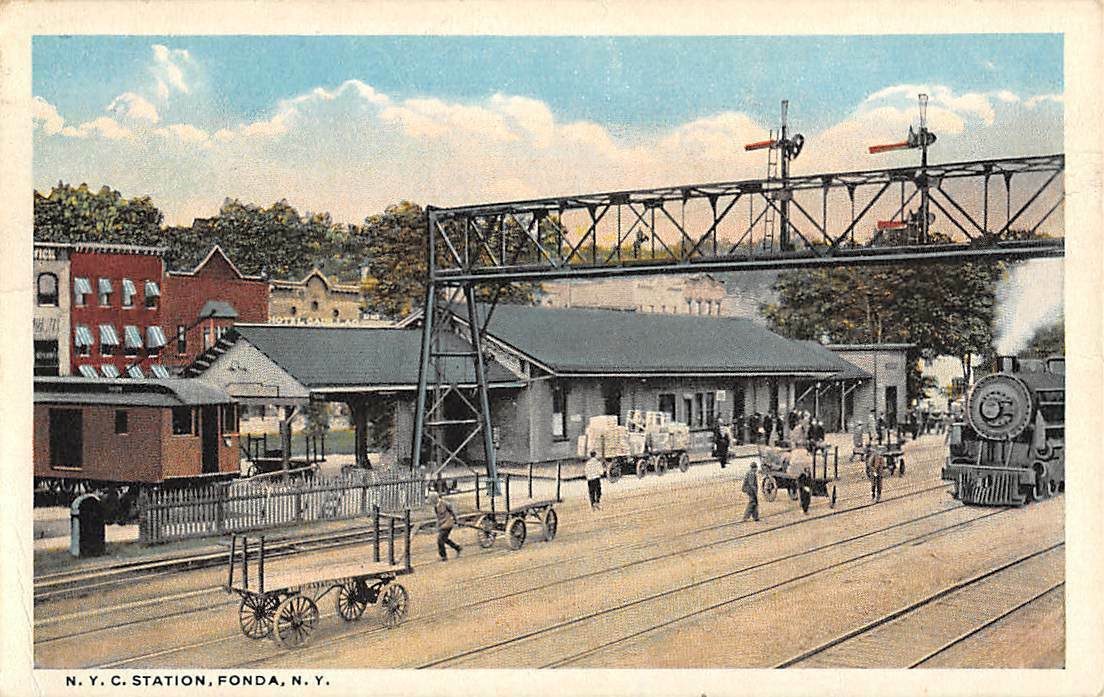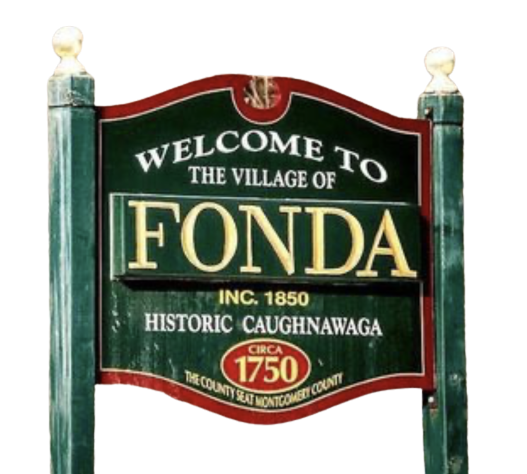
HISTORY
Fonda, New York is a small town located in Montgomery County, in the state of New York. The area where Fonda is located was originally settled by Dutch and German immigrants in the late 17th century. The town of Fonda was officially established in 1793, and named after Douw Fonda, a prominent early settler.
During the 19th century, Fonda was an important transportation hub, with several railroads running through the town. This made it a center for industry and commerce, and the town grew rapidly in population. Fonda was also known for its agriculture, with many farmers growing crops such as wheat, corn, and potatoes.
In the 20th century, Fonda's economy shifted from manufacturing and agriculture to service and tourism. The town's proximity to the Adirondack Mountains and the Mohawk River made it a popular destination for outdoor recreation and tourism.
Fonda is also home to the Fonda Fairgrounds, which hosts an annual fair and various other events throughout the year. The fairgrounds has a rich history, dating back to 1867. Today, Fonda is a small town with a population of about 698 people and a strong sense of community.
FONDA HISTORY SEARCH
FOUNDER
Douw Fonda, considered to be the founder of the village, originally known as Caughnawaga, settled in Fonda in about 1750. The village itself extended from the old stone church and parsonage to Douw Fonda's trading post near the river within the circle of the present race track. He also founded the Fonda family a branch of which is still in possession and residence of the original eighty-four and one-half acres willed by Douw to his descendants. The east end of the village is still to this day, often referred to as Caughnawaga. Its name in the Iroquois language is "Kanawake" and means "above the rapids". One of Douw Fonda's three sons, Jelles (or Giles), born in 1727, was an extensive landholder and trader in the village, and during the Revolutionary War he served as a major in the Tryon County Militia. His home was burned with others during the raid on Caughnawaga. A local heroine, Margaret (Peggy) Wemple, daughter of Douw Fonda, milled flour for Washington's army and frontier forts. Her home was built in about 1780, and survived the rigors of time until a few years ago when it was torn down and replaced by a mobile home. It was located on Putman Avenue. The home of Major Jelles Fonda, erected in 1790, which he did not live to occupy, stands erect today on Montgomery Terrace.
When the old Tryon County was formed from Albany County in
1772, the county seat was Johnstown. In 1836, Fonda became the
county seat as result of one, its geographical location in the center
of the county, two, due to the growth in population and construction
of the Utica and Schenectady railroad, and three, the old road to
Johnstown was, of course, not paved, and at times was difficult to
travel on. Fonda's Old Court House, built in 1836 and one of the
finest examples of Greek Revival architecture in the state was built
on the site of the home of the last Colonial Sheriff of Tryon County,
who was Tory and fled to Canada.
Our pioneer settlers were governed by the laws of God, thus the
erection of the Old Caughnawaga Dutch Reformed Church in 1763.
The church was torn down in 1861 but in 1843 another had been
erected at Center and Railroad streets and moved to the present lo-
cation in 1868. The Rev. Barent Vrooman was the supply minister
1758-1794. Prior to 1850 Catholic services were conducted in pri- in
vate homes, and in 1850 St. Patrick's of Johnstown was established
as a mission and later a parish and catholics in the Fonda area at-
tended this parish until the first Catholic church was built on Main
Street in 1875. In 1923 the present church site was purchased and
in 1926 a new church was officially opened for services, Easter
Sunday, 4 April, and is currently in use. The Methodist Church has
it's history in the visitations of circuit riders, who preached in small
groups. The chruch was organized in 1842 and a church was built.
In 1843 due to the many new members a second edifice was built
which was destroyed by fire in 1912. In 1913 another building was
erected, which remain standing,. The congregation united with the
Fultonville church and the building is now occupied by the Fonda is
Bible Church.
The Rev. F. D. McGuire was the first resident priest of the Catholic
Church, and Rev. R. W. Pierson was the first minister of the Meth-
odist Church and the Rev. James Hutchings Handy Brown was the
first pastor of the Zion Episcopal Church. Services were not held
after 1933, but the Zion church still remains standing.
The Village of Fonda was incorporated in 1850 upon the petition to
the Court of Sessions, and the order confirmed at an election held
October 4. Only three were against the incorporation and seventy-
eight for it. The village included 312 acres. In 1868 the main
streets were paved and in 1865 a bridge was built across the Mo-
hawk. The first bridge constructed in 1811 was carried away by
the spring freshet, as was the second bridge built in 1825. These
bridges were toll bridges.
The earliest efforts in manufacturing were made in 1811, when
Grist Mills were built along the Cayadutta Creek. Fulling Mills
were also started by John and Simon Veeder, Henry Fonda, G. Van
Dusen and Myndert Wemple. In the 1890's, a knitting mill was
started by John and Robert Own and was operated until it was de-
stroyed by fire. Later on a similar mill was operated but proved
unsuccessful. A third attempt was made by James Shanahan and
that was a success. Flour and feed mills, paper mills and a success-
ful cheese factory comprised nearly all of the manufacturing. In the
early 1900's the Cayadutta Knitting Co. was taken over by Con-
gressman Lucius Littauer of Gloversville. It then became the Fonda
Glove Lining Co. and then the Fonda Manufacturing Corp. which
was destroyed by fire in the 1970's. The remains still stand. The
only industry in the village now is Kasson and Keller, manufacturer
of aluminum products, located on School Street. The building was
originally the old Fonda High School. The first school in Fonda
was located in Caughnawaga, in the early 1800's. In 1938 a new
erected. In 1958 the Fonda-Fultonville Central School was built
and a middle school was added in 1971. The 1938 Fonda High
School was purchased by Montgomery County and still houses sev-
eral county offices.
In 1892 the New Court House was built, due to the noise of the rail-
road right near the 1836 Old Court House. In 1965 the New County
Office Building was built.
When the county seat was moved from Johnstown to Fonda in
1836, the Johnstown Herald newspaper was brought down also.
The name was later changed to The Fonda Sentinel in 1843 under
new ownership. In 1855 William S. Hawley established the Ameri-
can Star in Canajoharie and five weeks later it was removed to
Fonda where it was printed on the second floor of the Reformed
Church Parsonage. The paper was acquired by Charles B. Freeman
and the name was changed to the Mohawk Valley American. This
paper was later consolidated with the Fonda Sentinel and was re-
named The Mohawk Valley Democrat. William B. Wemple, Sr.
purchased the "Democrat", as it was commonly called, May 1, 1912
and on his death in 1924 the paper was under the management of
his son William Barent Wemple, Jr.. In 1956 the paper was pur-
chased by Chester Gizarra who later sold it to Lee Publications,
April 19, 1988. It became defunct a few years later.
The Old Fonda Jail and Sheriff's Department were replaced in 1997
by the Ronald E. Emery Public Safety Facility, now located on
Route 5-S in Glen.
The Frothingham Free Library came into existence through the gen-
erosity of a bequest left by Rev. Washington Frothingham, and re-
mains as an excellent educational repository, with programs for all
ages.
Rev. Frothingham wrote several books as an author but he was also
a journalist, philanthropist, and a very active minister. In the Fonda
Section of his book History of Montgomery County, published in
1892, he made the following statement "Fonda, indeed, has a very
promising prospect in the future",
Many public events have taken place over the years but most con-
sistent of these is the "Fonda Fair". The first fair was held on the
Old Court House grounds in 1844 and is still an annual fall event.
Another public event is the "Fonda Speedway", started in 1953 and
is still drawing thousands of fans weekly from all over the country.
